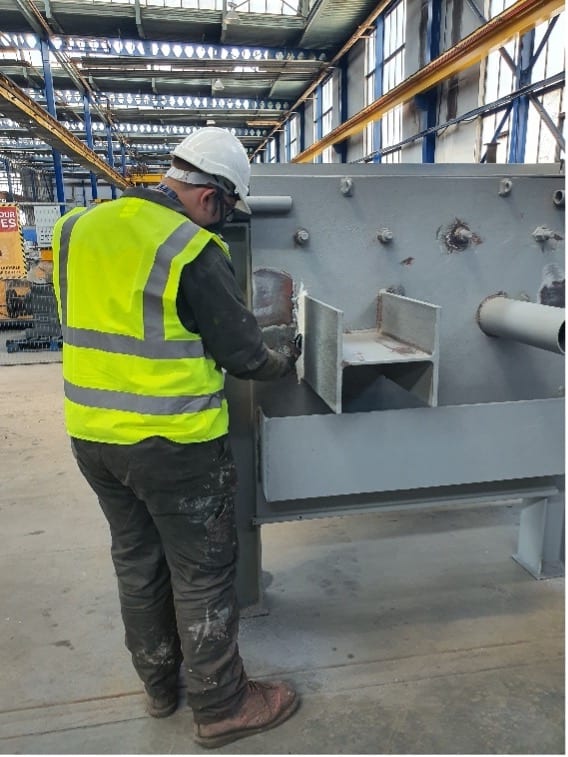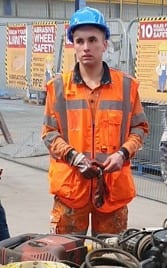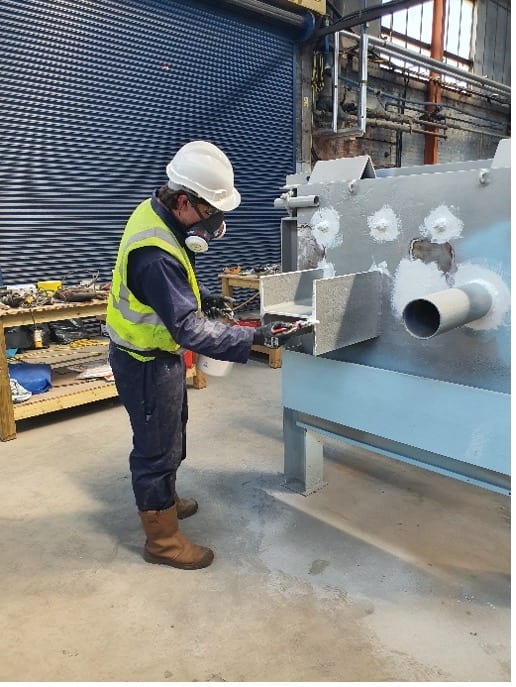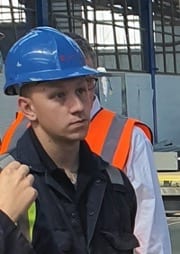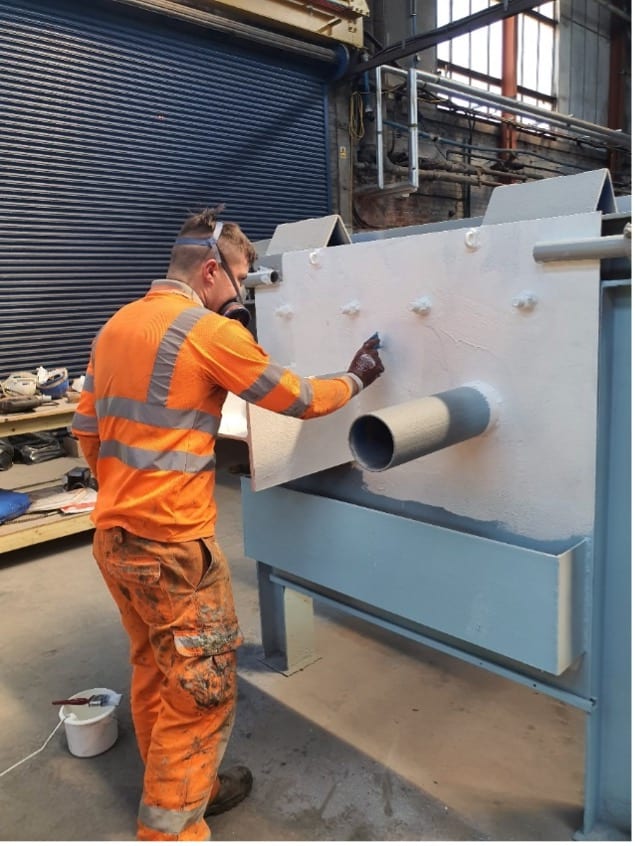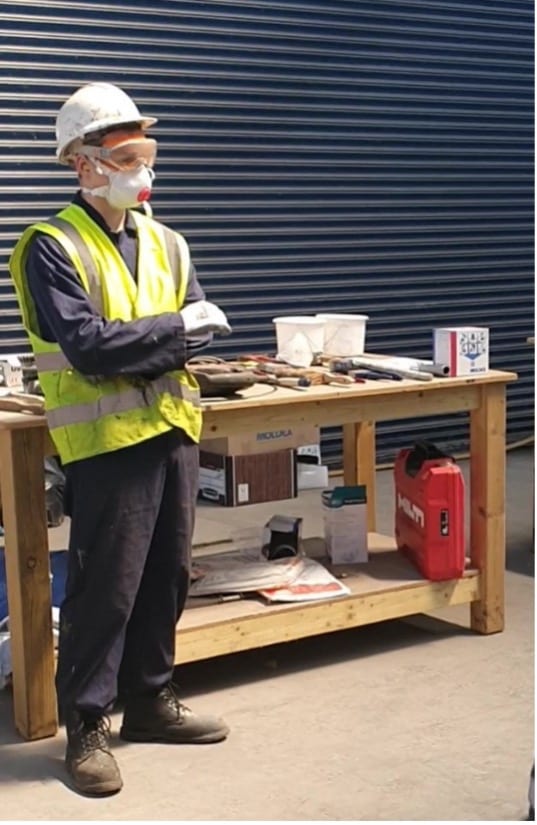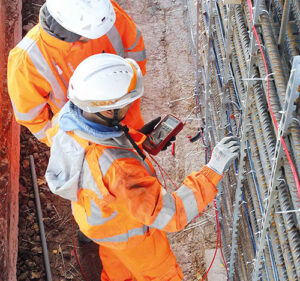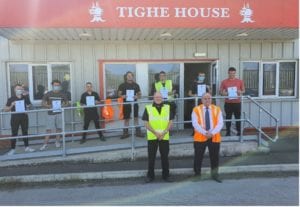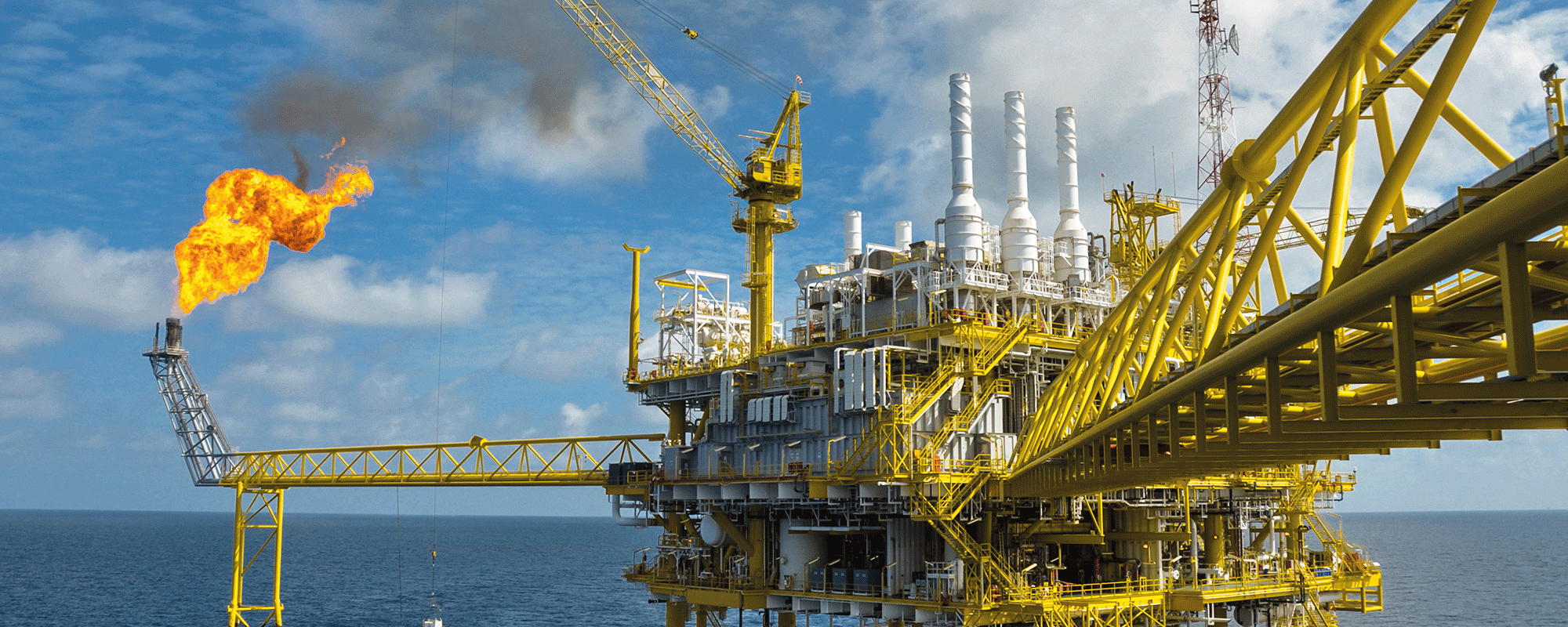
Fellows Corner
Non-metallic materials are an essential element of facilities engineering in upstream E&P operations, being widely used in a range of functions from seals and corrosion barriers to piping and structural elements. This short article offers a brief insight into the capabilities of some of the available options.
In common with metallic materials, the selection and successful use of non-metallics is dependent on a detailed understanding of the way in which each material responds to the service environment over the life of the component, or system. Degradation of the capabilities of non-metallic materials can occur through a range of physical and chemical processes.
Elastomers (or rubbers), are widely used in oilfield sealing applications. These are highly elastic, polymeric materials, used in compression seals in a range of downhole, subsea, topsides and pipeline applications. Various nitrile and fluorocarbon-based materials are typically used to span the range of temperatures, pressures and fluid environments, met in oilfield operations. Processing of these materials involves “vulcanisation” or curing, using small amounts of sulphur, amines or peroxides to create highly flexible and extendable polymers.
A number of key failure modes can affect elastomer seals. Some relate to the elastomer material being used outside its working temperature range, or in fluids with which it is incompatible. This can lead to chemical embrittlement, softening, compression set, large volume changes, and loss of elasticity at low temperature – any or all of which can lead to a seal failing. Pressure related failure modes can also be important. Extrusion damage occurs when a rubber seal is forced into the gap which it is sealing as a result of the applied pressure. Gas decompression damage occurs primarily in dry gas duty, being qualitatively similar to the “Bends” suffered by divers when returning to surface.
Qualification of seals and the material’s performance in any component or system, is typically carried out using a combination of materials and system testing, taking account of the time and temperature dependent properties of the materials involved. Finite element analysis (FEA) modelling of the complex, non-linear and time dependent materials properties of elastomers has proven vital in understanding some applications.
Further applications of a range of elastomer materials are to be found in hydraulic and transfer hoses, and in the flexible joints that are incorporated in metal drilling and catenary risers.
Thermoplastic materials, such as polyethene and nylon, find wide application in controlling the internal corrosion of steel pipelines. Such materials are fundamentally different in nature to elastomers, having a much smaller elastic range, and the way in which they are used is therefore somewhat different. As their name suggests, these materials are reversibly melt-processible, often being formed by extrusion for oilfield use. Materials are typically differentiated by their maximum service temperature capabilities, and their resistance to particular service fluids. So, for example, polyethylenes are typically used in water duties to a maximum of 60°C or so, while nylons can be used in hydrocarbon production service up to 90°C.
Thermoplastic liners have an extensive track record, both onshore and offshore, in providing a corrosion barrier within carbon steel pipelines, particularly for water injection service, where suitable metallic options are typically much more expensive or much less reliable. There are a number of “pull-through” liner technologies which can offer cost effective solutions to mitigate internal corrosion challenges in both new build projects and in rehabilitation. Often these involve “tight-fit” polyethylene liners, which have their outer diameter mechanically reduced, while they are pulled into a steel pipe. Release of the pulling force allows the polymer to relax back against the internal diameter of the pipe, which remains the structural element of the pipeline. Another option is the use so-called Reinforced Thermoplastic Pipes (RTPs) which are used, with good economic benefit, as loose fit, “slip liners” or even as stand-alone pipelines, in a range of production and injection services. These are composites in which glass, aramid or carbon fibre, or wire, reinforcement, is wound over a plastic pipe, in order to increase its pressure capability.
Thermoplastic materials additionally find wide application in unbonded flexible pipes, importantly being used as the internal and external sheathes in these complex pipe structures. The flexibility of these pipes often enables faster or more convenient offshore installation and hook-up, and provides excellent fatigue resistance in a range of harsh environments. Several thermoplastic materials are used as internal pressure sheathes, responsible for primary containment. Nylon materials are widely used in production service up to 60 – 90°C, with fluoropolymers used at high temperature, to around 130°C. In water injection, polyethylene is normally used. External, or outer, plastic sheathes contain the whole pipe structure, helping to keep the high strength steel wire reinforcement out of contact with seawater. Typically, this sheath is made of polyethylene for static pipes and nylon for pipes used in dynamic service.
Thermosetting materials, such as epoxy and phenolic resins, form the basis of a further set of related oilfield corrosion protection technologies. These materials employ a chemical hardener to permanently, and irreversibly, “set” the polymeric resin, often with temperature applied during curing to accelerate that reaction.
Fusion bonded epoxy (FBE) is used very widely as an external pipeline coating. It is applied as a powder to a carefully prepared surface, and melted and cured in situ to give a coating approximately 0.5 mm thick.
FBE also finds wide use as the base layer in multilayer coatings with polyethylene and polypropylene. Further, options for subsea insulation involving the incorporation of glass microspheres into thermoplastic layers are also widely accepted, for use on subsea pipelines. The thermoplastic nature of these materials allows the pipelines to be reeled for transport and installation, where required. Where more rigid insulation is acceptable, systems incorporating glass-microspheres into epoxy resins can be applied, for example to subsea manifolds.
Epoxy resins, and similar materials such as vinyl esters, find wide use in the painting and external protection of structures and equipment, as well as in the internal coating of vessels, typically in combination with glass flake fillers.
Glass reinforced epoxy pipes find a range of downhole, piping and pipeline applications, mostly in water service. Typically, this kind of pipe is rated to 16 bar design pressure, although some small diameter products can go much higher than this, for example in downhole tubing applications. A range of adhesively bonded, mechanically jointed and threaded connections are used across the industry. Qualification of composite pipes, and other non-metallic pipe options, is normally undertaken through a series of full-scale pipe tests, including: pressure rating using long term (10,000 hr) testing of pipe and end fittings, characterisation of minimum bend radius for storage, transportation and operation, characterisation of axial load capability, testing of capability of the product to handle gas service, and performance of the product in UV. A range of other engineering design issues also need to be worked through with each product, such as internal surface roughness, heat transfer co-efficient, and pipe expansion due to pressure and temperature.
Glass reinforced epoxy pipes can also be used as a liner, with composite lined downhole tubing having a long track record of successful onshore use in a range of corrosive services, and in offshore water injection. Some composite liners are capable of continuous service at up to 80°C in water-based applications. Insertion of the stiff liner into the steel host, on a joint-by-joint basis, leaves a small annulus between the liner and the host which is typically filled with cement, to transfer mechanical and pressure loads to the carbon steel host. Modified tubing connections allow the liner to be properly terminated, with thermoplastic corrosion barriers providing continuity of corrosion performance.
Finally, it is worth mentioning the use of external epoxy composite wraps to repair and reinforce topsides piping. This is a very convenient repair technology that does not involve hot work and which can be used to seal thinned, cracked or holed piping, at very least as a temporary solution until full repair can be affected.
The use of non-metallic components is an integral part of the materials selection challenge in oil & gas production. Given their frequent role in maintaining a primary or secondary containment, selection and use of these materials should be as carefully scrutinised as with the metallic components within any well, processing facility or pipeline.
For additional information see, B Kermani and D Harrop, Corrosion and Materials in Hydrocarbon Production; A Compendium of Operational and Engineering Aspects, Wiley, 2019, Chapters 9 & 15.
Ask the Expert
Question:
What are the advantages and limitations of impressed current CP compared to sacrificial anodes, and where would you use one opposed to the other? BK
Answer:
In order to help readers of Corrosion Management to understand the differences between impressed current and sacrificial anodes cathodic protection systems, let me to start with a brief definition of both systems, where they are installed, type of anodes, sources of energy, and finally indicate what their advantages and limitations are. In both applications, CP current flows from the anodes, through the electrolyte to the structure being protected.
Impressed current systems
The impressed current systems use an external source of energy to provide direct current for cathodic protection. Generally, they are used when large quantities of protective current are required, for bare structures, those with poor coatings, or when the resistivity of the electrolyte is over 5000 Ohm-cm. They are also used for most long
buried pipelines, irrespective of coating quality and for above ground storage tank bottoms, seawater intake systems, interiors of fresh water tanks, well casings and many ship hulls. They are used for some piers, jetties and offshore structures if power is available.
Types of impressed current anodes
Dimensionally Stable Anodes: Substrates of titanium and niobium with coatings of platinum and mixed metal oxides (MMO) of ruthenium and iridium. Presently MMO/Ti are most commonly used.
Ferrous Metals: iron-silicon-chromium, iron-silicon-chromium-molybdenum, iron with high silicon, cast iron, carbon steel, stainless steel. Presently Fe-Si, with Cr in chloride rich areas and Fe-Si are most commonly used. Anodes of magnetite (Fe3O4) are also used.
Lead and graphite-based materials have historically been used but the superior performance of the materials above has caused the cessation of their use. Coke breeze is widely used in conjunction with suitable anodes, in buried applications, to effectively decrease resistance and increase life.
Non-ferrous metals: aluminium and zinc are used in some very specialised applications and copper in anti-fouling systems.
Energy sources
Transformer Rectifiers: single-phase or three-phase, extensive range of input voltages (120, 220, 480V AC), cooled by air or oil, typically with silicon diode rectifiers; these deliver low voltage DC for the cathodic protection. They can be simple constant Voltage, or constant Current and or Potential Controlled. The second are used when the design needs constant level of current. The last when it is required to automatically adjust the output to maintain constant structure/electrolyte potential with respect to a permanent reference electrode. Mains electricity and transformer rectifier normally provide the lowest cost and highest reliability impressed current for CP.
Solar Energy: utilised in those locations where there is no commercial power source available. They require batteries to deliver CP power at night and poor weather when solar energy is not available.
Wind Energy: is used where there is no electric energy and the solar energy is limited. They require batteries to supply current when there are no winds.
Thermoelectric Generators: utilised as a low voltage DC supply in remote places where there is availability of hydrocarbon fuels (e.g. natural gas, methane, propane). They are high technology equipment and require periodic maintenance.
Galvanic anode CP systems
Galvanic anode systems deliver CP current due to the difference of the electrochemical potential between them and the structure. The anodic materials is more active in the electrochemical or galvanic series of metals than the structure material. Galvanic (or sacrificial) anodes are generally used in environments of low electrical resistivity. Typical applications are: offshore oil and gas platforms and pipelines along with offshore wind foundations, ports and harbour facilities. These are all quite high current applications Smaller current applications are those such as short sections of buried pipelines, internals of flooded vessels or structures like barrages, oil field production vessels, water knock outs, desalters and separators, water storage tanks.
Types of galvanic anodes and uses
Magnesium: Soils, typically with resistivity up to 10000 ohm-cm, typically pre-packaged with a backfill of gypsum (75%), bentonite
(20%) and sodium sulphate (5%). Can be used in ribbon form.
Zinc: environments with resistivity lower than 2000 ohm-cm. Cn be used in soils with backfill of gypsum (50%) and bentonite (50%). Deficient operation in electrolytes that contain bicarbonate, carbonates and nitrates. Limited to temperatures up to 60°C. Can be used in ribbon form.
Aluminium: The main use of aluminium alloy anodes is in seawater and marine sediments environments, such as offshore platforms and pipelines. Deficient operation in electrolytes of pH alkaline (>8); in closed compartments with no replenishment can cause significant reduction in pH and inadequate performance.
|
Cathodic Protection System
|
Advantages
|
Limitations
|
|
Impressed Current
|
Significant range of driving voltages and higher
and adjustable current outputs
Operation in extensive range of resistivity
Great variety of anodes with very low rates of consumption
Electronic control and monitoring can be advantageous and reduce inspection and maintenance costs. Often essential in severe fluctuating DC traction interference
Can be operated at constant current or constant potential adjustment
Reliable onshore and if properly maintained, on ships
|
Require external source of energy
More likely to generate stray current interference
to foreign structures than galvanic anode
Susceptible to deterioration by external conditions, particularly offshore
Require monitoring of potentials for safe operation to avoid over and under-protection
Offshore systems may have high inspection,
control and maintenance requirements
More complex and in some applications, less
reliable than galvanic anode systems
Electronic control and monitoring can cause additional complexity and lower reliability
|
|
Sacrificial Anodes
|
Robust, simple and reliable
Generally easy installation and few components
Low costs of installation and maintenance
Do not require external sources of energy
Generally cause limited interference or interference problems with other structures
|
Limited driving voltage
Low and limited current output from individual anodes
Life is a function of the anodic mass
Attacked in acid environments
Operation affected by the environment resistivity
CAPEX can be higher than impressed current systems, but, generally, OPEX is generally less
|
Question:
What is the impact of corrosion on the offshore renewable sector, and how is this being controlled? AN
Answer:
The world is depending more and more on clean renewable energy as opposed to that based on oil and gas, and the renewable sector is rapidly becoming one of the biggest energy sectors in the world, with wind farms breaking records for output and size. However, with these farms come many of the same corrosion and engineering challenges that have been faced by the oil and gas sector for many years. Corrosion is a major risk for offshore wind foundations, its effects could mean costly offshore retrofit work, resulting in the loss of energy generation, and expose operatives to additional health and safety risks. Corrosion protection is thus of vital importance to assure the integrity of offshore structures, to minimise exposure to these risks.
It is estimated that the cost of painting an offshore structure in a dedicated painting facility can be up to 25 percent less per square metre compared with coating onsite. In addition, costs brought about by repair work to a new coating system carried out onsite have been estimated by one coating manufacturer to cost up to 5 to 10 times more per square metre compared with repairs made in the shop. A report by TWI stated that a recent coating failure on a wind farm off the coast of Ireland cost over £2m to rectify, 20 times the cost of the original installation itself
Thus, it makes sense to complete the corrosion protection of any structure in a paint shop or facility straight after fabrication—including painting, inspection and any necessary repairs. A corrosion protection strategy should be an integral part of the production process, and an appropriate time frame allocated in order to successfully execute the painting programme prior to delivery. It’s a simple concept, in order to increase quality and reduce costs, owners must ensure the dedicated site team includes a corrosion control specialist during design, construction, and commissioning, in order to ensure that the work is carried out on time and to the required specification.
Most of the standards available for offshore corrosion protection of wind turbine towers have been used in the oil and gas sector industry for many years, including ISO 12944 and NORSOK M-501. However, it is often seen in the recruitment adverts for corrosion control and QA/QC personal, the requirements being specific to the renewable sector, many whom are not familiar with the oil and gas sector, which in turn has created its own issues and subsequent failures and delays to project execution.
There are a number of different wind tower structural configurations, and these can a have an impact on the protective coating system applied. Although the external corrosion at the splash zone and tidal areas has been of great concern to the industry, particularly when dealing with the stress and fatigue related parameters of the towers, this corrosion in general is well understood and very similar to the challenges observed across other offshore facilities. However, internally, in the closed compartments, the current guidelines and standards are inadequate, as with data from inspections and surveys becoming available, major Issues such as fatigue and stress issues, design and material selection, cathodic protection, need to be addressed.
Experiences with internal corrosion have shown that it is difficult in practice to completely seal compartments and render them airtight. If the closed-compartment structure is not properly sealed, direct ingress of air is certainly possible. One major certification society has noted that seawater and air (oxygen) ingress were detected in foundations that are as new as two years old, which increased the rate of corrosion and localised corrosion attack. After the commissioning of monopile foundations in many offshore wind farms, corrosion problems have been observed inside of the monopiles in the area located beneath the so-called ”air-tight deck”. The cause of this corrosion has been usually a failure of the subsea cable entrance seal which allows air (oxygen) to penetrate into the monopile. This is in complete contradiction to the assumption that the submerged internal area is a ”gas-free” area, with a low corrosion risk due to a limited presence of oxygen after initial oxygen depletion. There is also a risk of microbiologically influenced corrosion (MIC) in a closed-compartment foundation, with localised corrosion attack on the submerged surface and in the portions of the monopile buried in the upper region of the sediment. Alternating aerobic and anaerobic conditions may also favour bacteria growth, and the risk of MIC depends on the bacteria species and the environmental conditions present. Sulphur-reducing bacteria (SRB) are expected to be present, and if growth conditions are favourable, then sulphide production can occur. Differences in the state of the tide result in variation of the water level inside the pile, and this has led to micro-organism in the seawater, that do not require oxygen to survive, such as SRB. Some suppliers insist on placing cables inside the tower going through the pile and leaving the structure through a hole below the water known as the rat hole which is sealed. This seal has proven in many cases to be inadequate and again allows water ingress into the pile.
The offshore wind energy sector is facing major challenges and not fully addressing the corrosion issues, nor implementing strategic corrosion management systems from the design stage, due in part to the demand pressures for supply to meet the energy requirements.
Lee Wilson, Corrtech Ltd.
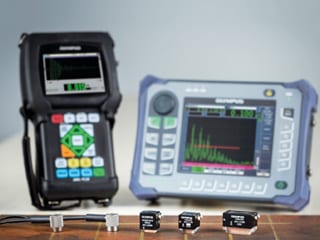
Innovative Products
Olympus has announced its new DC series (DC1–DC5) dual element transducers to provide inspectors with a complete corrosion monitoring toolbox for pipeline and tank integrity. Optimised for corrosion and thin materials, the transducers work with the NDT instruments and ultrasonic inspection procedures used in the oil & gas, energy and mining industries. According to the company, depending on the application, any one or a combination of these five transducers offers improved corrosion monitoring and defect sizing. As field inspections change, inspectors can benefit from having the complete set of transducers with a total combined thickness range of 0–50 mm, as well as the extra pipe weld inspection tool with the DC3 model.
All models provide a cleaner signal than single element transducers, and offer less ring down than comparable models—helpful for resolving smaller defects, inspecting close to the surface and differentiating between two indications.
Featuring a thick-walled, wear-resistant housing (DC2 model) and replaceable wedges (DC4 and DC5), the transducers are built to last. A heat-resistant delay line up to 150 C on the DC1 and DC2 models helps reduce maintenance time for elevated-temperature pipe and tank inspections, concluded the company.
For more information about the DC series dual element transducers visit Olympus-IMS.com

Innovative Products
Indestructible Paints Ltd, a UK manufacturer of high-performance protective coating systems for the aerospace and land defence industries, utilising the latest polymer technology have now adopting this technology for use within the passenger and freight rail sectors, including underground vehicles, offering excellent corrosion protection in aggressive operating conditions.
According to the company, its first fully compliant product for use on underframe components is a high solid solvent-based epoxy product, RWIP120. It can be applied as a single coat direct to the substrate or 2 coat application, primer, and finish, which can be overcoated with itself and other epoxy, and polyurethane coatings. RWIP120 is part of a family of coatings which are ideally suited for use on underframe components including bogies, wheelsets, motors, fluid or air receivers, control enclosures, support structures, etc. The composition of the epoxy and its chemical bonding properties allows use on a range of substrates including ferrous and non-ferrous metallics, GRP mouldings and a wide range of composites. The cured coating is a tough chemically resilient finish that has been tested against a variety of corporate and national standards including CR/PE0102 and EN45545-2 for Fire Smoke and Toxicity, concluded the company.
